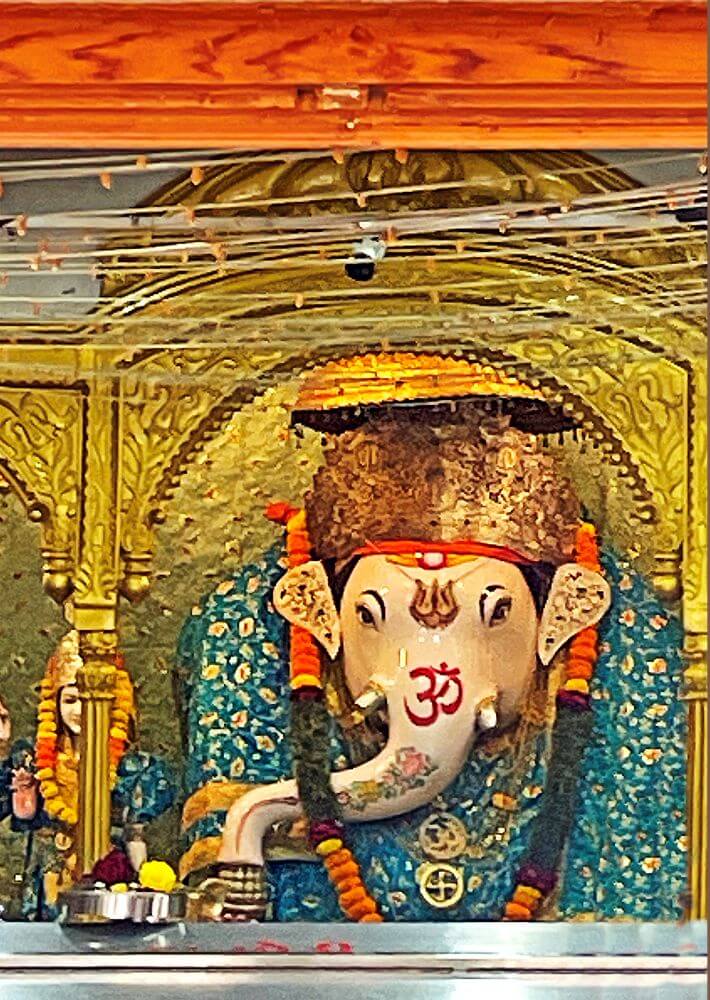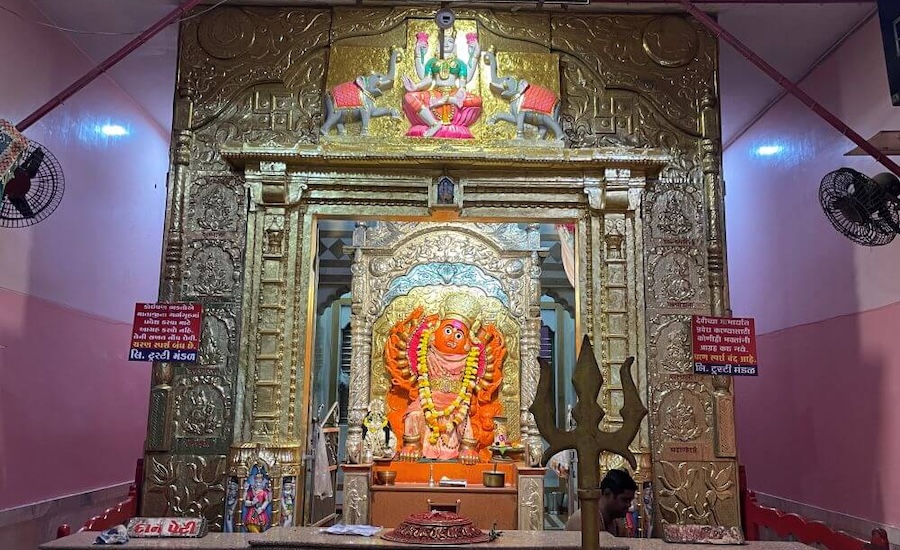
 Bada Ganesh Temple in Surat is a revered shrine dedicated to Lord Ganesha, the remover of obstacles and the deity to whom devotees pay homage before beginning any auspicious endeavour. This temple holds a unique legend surrounding its origin. It is said that during the annual Ganesh Chaturthi celebrations, the idol brought for worship unexpectedly grew in size and weight, earning it the name Bada Ganesh. Devotees believe that Bada Ganesh is highly miraculous, fulfilling wishes and granting blessings. As a result, hundreds of devotees visit the temple daily for his darshan.
Bada Ganesh Temple in Surat is a revered shrine dedicated to Lord Ganesha, the remover of obstacles and the deity to whom devotees pay homage before beginning any auspicious endeavour. This temple holds a unique legend surrounding its origin. It is said that during the annual Ganesh Chaturthi celebrations, the idol brought for worship unexpectedly grew in size and weight, earning it the name Bada Ganesh. Devotees believe that Bada Ganesh is highly miraculous, fulfilling wishes and granting blessings. As a result, hundreds of devotees visit the temple daily for his darshan.
According to local lore, the people of the Katargam Extention area had been celebrating the Ganesh Chaturthi festival for many years with great devotion. One year, they brought a small idol of Lord Ganesha for the festival. However, the pandal (festival marquee) where the idol was to be placed was still under construction. Suddenly, heavy rain and strong winds began to lash the area. To protect the idol from getting soaked, the devotees rushed to move it to a safer location. Despite their collective efforts, the idol would not budge from its place. The devotees tried repeatedly until late into the night, but the idol remained immovable. Exhausted, they eventually laid down near the idol and fell asleep. The next morning, they awoke to find the small idol had transformed into a massive, towering figure. Witnessing this miracle, the locals decided that instead of using the idol only for the festival, they would construct a permanent temple to house this divine form of Bada Ganesh.
they would construct a permanent temple to house this divine form of Bada Ganesh.
The temple is situated on Bal Ganesh Road, near Alkapuri Bridge in Katargam, Surat. Nestled along a lane beside New Pushpakunj Society, the temple can be accessed via a narrow street with an organised system for devotees to queue up for darshan.
The structure of the Bada Ganesh Temple is modest, reflecting its humble origins. A small courtyard greets visitors at the entrance, with a small shrine dedicated to Lord Hanuman to the left. The temple itself consists of a simple sabhamandap (assembly hall) and a sanctum (garbhagriha). In the sanctum, the grand idol of Bada Ganesh is enshrined on a raised golden pedestal (vajrapitha). The idol of Bada Ganesh, depicted with a right-curved trunk, is adorned with ornate garments and jewellery. There is a common belief that Ganesh idols with a right-curved trunk require strict rituals and adherence to purity, often considered more demanding in terms of worship practices. However, noted astrologer D. K. Soman offers a contrasting perspective, stating that Ganesh is never rigid or difficult to please. He emphasizes that Lord Ganesh is inherently compassionate and forgiving, embodying boundless mercy and grace for his devotees. Only the left hand of the idol, holding a modak (a sweet symbolic of Ganesha), is visible from the outside. The idol is further embellished with various crowns and decorative attire that change over time. At the foot of the idol, a silver mouse (mushak) symbolising Lord Ganesha’s vehicle stands in devotion. On either side of the idol, the sanctum features Riddhi and Siddhi on one side, while Lakshmi-Narayan and Ashtabhuja Ambamata (a form of Durga riding a lion) are enshrined on the other.
The idol of Bada Ganesh, depicted with a right-curved trunk, is adorned with ornate garments and jewellery. There is a common belief that Ganesh idols with a right-curved trunk require strict rituals and adherence to purity, often considered more demanding in terms of worship practices. However, noted astrologer D. K. Soman offers a contrasting perspective, stating that Ganesh is never rigid or difficult to please. He emphasizes that Lord Ganesh is inherently compassionate and forgiving, embodying boundless mercy and grace for his devotees. Only the left hand of the idol, holding a modak (a sweet symbolic of Ganesha), is visible from the outside. The idol is further embellished with various crowns and decorative attire that change over time. At the foot of the idol, a silver mouse (mushak) symbolising Lord Ganesha’s vehicle stands in devotion. On either side of the idol, the sanctum features Riddhi and Siddhi on one side, while Lakshmi-Narayan and Ashtabhuja Ambamata (a form of Durga riding a lion) are enshrined on the other.
After darshan, devotees circumambulate the temple, often stopping to bow and place their foreheads against the walls of the sanctum, praying earnestly to Lord Ganesha. Nearby, there is a designated area for offering Shriphal (coconuts). A temple-appointed trustee breaks the coconut and distributes half as sacred prasad to devotees. As devotees exit the temple, they find red vermilion (kumkum) offered to Lord Ganesha kept for blessings. They apply this kumkum to their foreheads, taking the divine essence of the temple’s blessings with them.
they find red vermilion (kumkum) offered to Lord Ganesha kept for blessings. They apply this kumkum to their foreheads, taking the divine essence of the temple’s blessings with them.
The devotees of Bada Ganesh firmly believe that their prayers never go unanswered. This temple is seen as a sanctuary where wishes are fulfilled, drawing numerous worshippers every day. Regular rituals and prayers are conducted here, along with vibrant religious celebrations throughout the year. The temple becomes a focal point during the grand Ganeshotsav festival, celebrated with enthusiasm and devotion. Both the Gujarati and Marathi communities, who reside in large numbers in the area, participate in the festivities. The celebrations feature cultural and devotional events, adding to the festive spirit.
On Tuesdays, the temple sees an especially high influx of devotees, with many arriving as early as 4 a.m., some walking barefoot, as a mark of devotion. The streets outside the temple bustle with activity, resembling a fair. Vendors set up shops selling puja items, clothing and other goods, catering to the crowd. Apart from Tuesdays, devotees can visit the temple from 7:00 a.m. to 10:00 a.m. and 5:00 p.m. to 8:00 p.m. for darshan.



